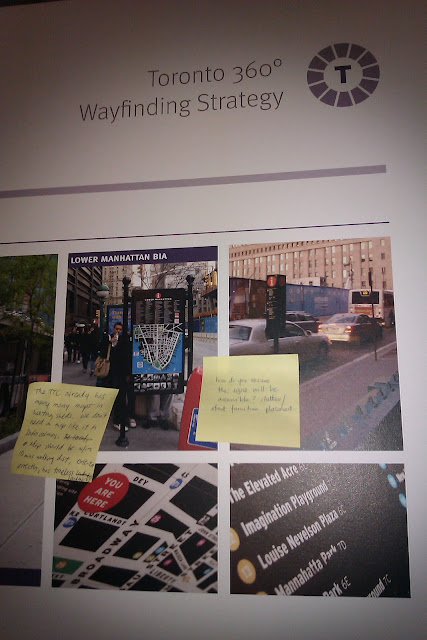As most #TransitHubbers know, how to get around is almost as important as what to do when you get there...
That is why the team from TransitHub.ca was thrilled to take part in the City of Toronto's Wayfinding Panel, an event open to the public, held on March 28, 2012 inside the Metro Hall Rotunda. For #TransitHubbers, it was just a few steps away from the #JohnKing Hub. The team arrived just moments before the presentation began, and we quickly found our seats. What would we hear? We weren't quite sure. But we knew that TransitHub would most-definitely benefit from it.
Wayfinding is all about how people orient themselves in a physical location, and how they determine how to move from one location to another. But, as many Torontonians know, it isn't always easy to find your way around the city. Toronto's Wayfinding Strategy was developed in order to help people become better oriented with the city around them, so that they can more easily explore it.
Specifically, the initiative is meant to:
- Identify and connect places
- Encourage people to move from one place to the next
- Build confidence in people so that they are free to explore
- Make the city a more comfortable place to be in
- Facilitate quick travel, less time lost to "confusion"
- Ultimately, generate more economic activity throughout the city
Hmmm... sounds a lot like what TransitHub.ca does! Hmmm...
Next the presenting firm outlined some of the issues that they faced when developing their Wayfinding Strategy. First, naming. What should they call the places in between Toronto's major neighbourhoods and landmarks? How would they ensure that the same naming convention is used on all media? How could they use names to create memorable places?
Second, the order of the information hierarchy. What information is most important? Which details are better off saving for later on in the journey? Third, accessibility. How could they ensure that those whom are visually impaired or hard of hearing are able to use the Wayfinding system as well?
Finally, the benefits of the Wayfinding Strategy were presented. Number one, a consistent look, feel, and design language across the entire city. Many of the Wayfinding tools that are scattered around the City of Toronto, whether signs or kiosks, are legacy items left over from previous initiatives. They don't connect and often use their own iconography and design language. The new system should communicate a common theme throughout the city. Two, inclusivity. It should include and make use of existing design elements and iconography as well. Three, sustainability—it should be built to last, and be viable even through neighbourhood transitions. Fourth, it should be "local" and adapt to each distinct area of the city—from Chinatown to the Danforth.
Once the Wayfinding Strategy moves forward and into the piloting stage, the city is hoping that it will prove effective enough to warrant a roll-out across the entire city—in time for the 2015 Pan Am Games. What do you think #TransitHubbers? Maybe Toronto just needs a little more TransitHub.ca to help people get to where they need to go? ;)
















0 comments:
Post a Comment